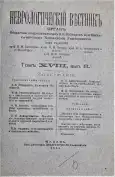About hallucinations and pseudo-hallucinations
- Authors: Rudnev V.I.1,2
-
Affiliations:
- Novorossiysk University
- Saratov Psychiatric Hospital
- Issue: Vol XVIII, No 3 (1911)
- Pages: 665-714
- Section: Articles
- URL: https://journals.rcsi.science/1027-4898/article/view/71764
- DOI: https://doi.org/10.17816/nb71764
- ID: 71764
Cite item
Full Text
Abstract
From these examples it can be seen that subjectivity can be combined with objectivity, and how this phenomenon should be considered, for example, in Maupassant, as a hallucination or as a pseudo-hallucination from the point of view of Kandinsky. Of course, one has to consider it a hallucination, as Maupassant himself admits, since with visual pseudo-hallucinations, patients, as they themselves express themselves, see not usually with their eyes, but with mental eyes, therefore, it will be necessary to consider phenomena that are close to the images of fantasy as pseudo-hallucinations, when patients do not experience those usual peripheral sensations, as in hallucinations, in which the subject, although he may consider the given phenomenon to be subjective, but experiences the same sensation, as in peripheral stimuli.
Keywords
Full Text
##article.viewOnOriginalSite##About the authors
Vladimir I. Rudnev
Novorossiysk University; Saratov Psychiatric Hospital
Author for correspondence.
Email: info@eco-vector.com
Privat-Associate Professor of Novorossiysk University, Director of the Saratov Psychiatric Hospital
Russian Federation, Novorossiysk; SaratovReferences
Supplementary files






